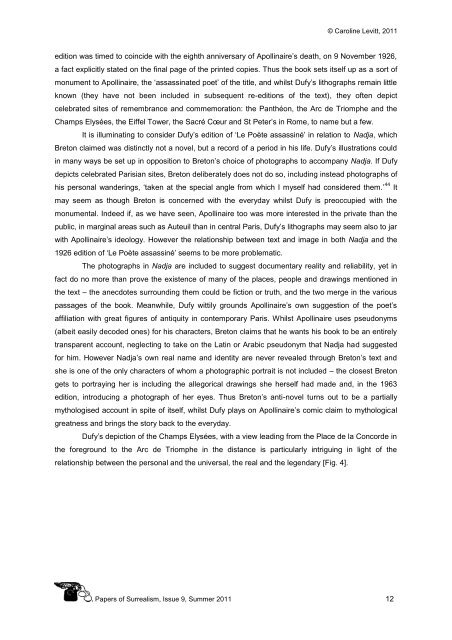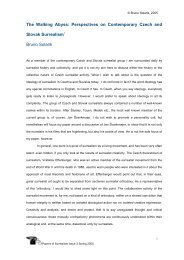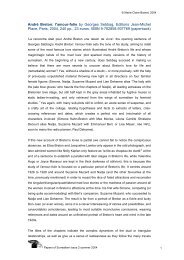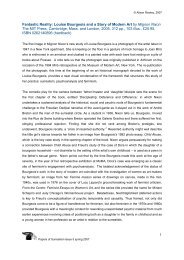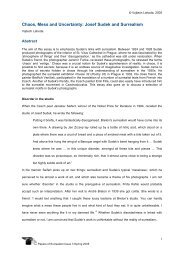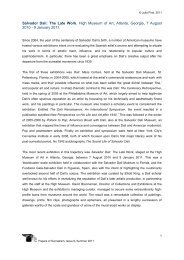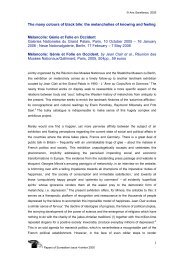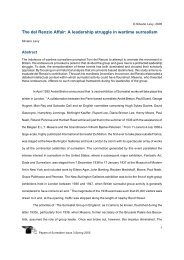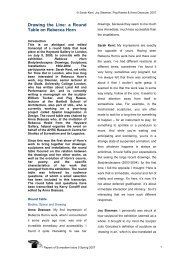From the Walls of Factories to the Poetry of the Street: Inscriptions ...
From the Walls of Factories to the Poetry of the Street: Inscriptions ...
From the Walls of Factories to the Poetry of the Street: Inscriptions ...
Create successful ePaper yourself
Turn your PDF publications into a flip-book with our unique Google optimized e-Paper software.
© Caroline Levitt, 2011<br />
edition was timed <strong>to</strong> coincide with <strong>the</strong> eighth anniversary <strong>of</strong> Apollinaire‟s death, on 9 November 1926,<br />
a fact explicitly stated on <strong>the</strong> final page <strong>of</strong> <strong>the</strong> printed copies. Thus <strong>the</strong> book sets itself up as a sort <strong>of</strong><br />
monument <strong>to</strong> Apollinaire, <strong>the</strong> „assassinated poet‟ <strong>of</strong> <strong>the</strong> title, and whilst Dufy‟s lithographs remain little<br />
known (<strong>the</strong>y have not been included in subsequent re-editions <strong>of</strong> <strong>the</strong> text), <strong>the</strong>y <strong>of</strong>ten depict<br />
celebrated sites <strong>of</strong> remembrance and commemoration: <strong>the</strong> Panthéon, <strong>the</strong> Arc de Triomphe and <strong>the</strong><br />
Champs Elysées, <strong>the</strong> Eiffel Tower, <strong>the</strong> Sacré Cœur and St Peter‟s in Rome, <strong>to</strong> name but a few.<br />
It is illuminating <strong>to</strong> consider Dufy‟s edition <strong>of</strong> „Le Poète assassiné‟ in relation <strong>to</strong> Nadja, which<br />
Bre<strong>to</strong>n claimed was distinctly not a novel, but a record <strong>of</strong> a period in his life. Dufy‟s illustrations could<br />
in many ways be set up in opposition <strong>to</strong> Bre<strong>to</strong>n‟s choice <strong>of</strong> pho<strong>to</strong>graphs <strong>to</strong> accompany Nadja. If Dufy<br />
depicts celebrated Parisian sites, Bre<strong>to</strong>n deliberately does not do so, including instead pho<strong>to</strong>graphs <strong>of</strong><br />
his personal wanderings, „taken at <strong>the</strong> special angle from which I myself had considered <strong>the</strong>m.‟ 44 It<br />
may seem as though Bre<strong>to</strong>n is concerned with <strong>the</strong> everyday whilst Dufy is preoccupied with <strong>the</strong><br />
monumental. Indeed if, as we have seen, Apollinaire <strong>to</strong>o was more interested in <strong>the</strong> private than <strong>the</strong><br />
public, in marginal areas such as Auteuil than in central Paris, Dufy‟s lithographs may seem also <strong>to</strong> jar<br />
with Apollinaire‟s ideology. However <strong>the</strong> relationship between text and image in both Nadja and <strong>the</strong><br />
1926 edition <strong>of</strong> „Le Poète assassiné‟ seems <strong>to</strong> be more problematic.<br />
The pho<strong>to</strong>graphs in Nadja are included <strong>to</strong> suggest documentary reality and reliability, yet in<br />
fact do no more than prove <strong>the</strong> existence <strong>of</strong> many <strong>of</strong> <strong>the</strong> places, people and drawings mentioned in<br />
<strong>the</strong> text – <strong>the</strong> anecdotes surrounding <strong>the</strong>m could be fiction or truth, and <strong>the</strong> two merge in <strong>the</strong> various<br />
passages <strong>of</strong> <strong>the</strong> book. Meanwhile, Dufy wittily grounds Apollinaire‟s own suggestion <strong>of</strong> <strong>the</strong> poet‟s<br />
affiliation with great figures <strong>of</strong> antiquity in contemporary Paris. Whilst Apollinaire uses pseudonyms<br />
(albeit easily decoded ones) for his characters, Bre<strong>to</strong>n claims that he wants his book <strong>to</strong> be an entirely<br />
transparent account, neglecting <strong>to</strong> take on <strong>the</strong> Latin or Arabic pseudonym that Nadja had suggested<br />
for him. However Nadja‟s own real name and identity are never revealed through Bre<strong>to</strong>n‟s text and<br />
she is one <strong>of</strong> <strong>the</strong> only characters <strong>of</strong> whom a pho<strong>to</strong>graphic portrait is not included – <strong>the</strong> closest Bre<strong>to</strong>n<br />
gets <strong>to</strong> portraying her is including <strong>the</strong> allegorical drawings she herself had made and, in <strong>the</strong> 1963<br />
edition, introducing a pho<strong>to</strong>graph <strong>of</strong> her eyes. Thus Bre<strong>to</strong>n‟s anti-novel turns out <strong>to</strong> be a partially<br />
mythologised account in spite <strong>of</strong> itself, whilst Dufy plays on Apollinaire‟s comic claim <strong>to</strong> mythological<br />
greatness and brings <strong>the</strong> s<strong>to</strong>ry back <strong>to</strong> <strong>the</strong> everyday.<br />
Dufy‟s depiction <strong>of</strong> <strong>the</strong> Champs Elysées, with a view leading from <strong>the</strong> Place de la Concorde in<br />
<strong>the</strong> foreground <strong>to</strong> <strong>the</strong> Arc de Triomphe in <strong>the</strong> distance is particularly intriguing in light <strong>of</strong> <strong>the</strong><br />
relationship between <strong>the</strong> personal and <strong>the</strong> universal, <strong>the</strong> real and <strong>the</strong> legendary [Fig. 4].<br />
Papers <strong>of</strong> Surrealism, Issue 9, Summer 2011 12


